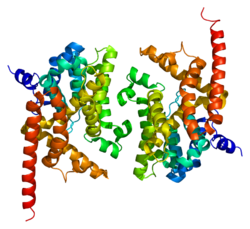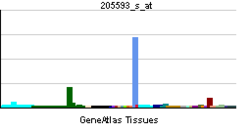- PDE9A
-
High affinity cGMP-specific 3',5'-cyclic phosphodiesterase 9A is an enzyme that in humans is encoded by the PDE9A gene.[1][2]
The protein encoded by this gene catalyzes the hydrolysis of cAMP and cGMP to their corresponding monophosphates. The encoded protein plays a role in signal transduction by regulating the intracellular concentration of these cyclic nucleotides. Multiple transcript variants encoding several different isoforms have been found for this gene.[2]
References
- ^ Fisher DA, Smith JF, Pillar JS, St Denis SH, Cheng JB (Jul 1998). "Isolation and characterization of PDE9A, a novel human cGMP-specific phosphodiesterase". J Biol Chem 273 (25): 15559–64. doi:10.1074/jbc.273.25.15559. PMID 9624146.
- ^ a b "Entrez Gene: PDE9A phosphodiesterase 9A". http://www.ncbi.nlm.nih.gov/sites/entrez?Db=gene&Cmd=ShowDetailView&TermToSearch=5152.
Further reading
- Guipponi M, Scott HS, Kudoh J, et al. (1998). "Identification and characterization of a novel cyclic nucleotide phosphodiesterase gene (PDE9A) that maps to 21q22.3: alternative splicing of mRNA transcripts, genomic structure and sequence". Hum. Genet. 103 (4): 386–92. doi:10.1007/s004390050838. PMID 9856478.
- Hattori M, Fujiyama A, Taylor TD, et al. (2000). "The DNA sequence of human chromosome 21". Nature 405 (6784): 311–9. doi:10.1038/35012518. PMID 10830953.
- Strausberg RL, Feingold EA, Grouse LH, et al. (2003). "Generation and initial analysis of more than 15,000 full-length human and mouse cDNA sequences". Proc. Natl. Acad. Sci. U.S.A. 99 (26): 16899–903. doi:10.1073/pnas.242603899. PMC 139241. PMID 12477932. http://www.pubmedcentral.nih.gov/articlerender.fcgi?tool=pmcentrez&artid=139241.
- Rentero C, Monfort A, Puigdomènech P (2003). "Identification and distribution of different mRNA variants produced by differential splicing in the human phosphodiesterase 9A gene". Biochem. Biophys. Res. Commun. 301 (3): 686–92. doi:10.1016/S0006-291X(03)00021-4. PMID 12565835.
- Wang P, Wu P, Egan RW, Billah MM (2003). "Identification and characterization of a new human type 9 cGMP-specific phosphodiesterase splice variant (PDE9A5). Differential tissue distribution and subcellular localization of PDE9A variants". Gene 314: 15–27. doi:10.1016/S0378-1119(03)00733-9. PMID 14527714.
- Ota T, Suzuki Y, Nishikawa T, et al. (2004). "Complete sequencing and characterization of 21,243 full-length human cDNAs". Nat. Genet. 36 (1): 40–5. doi:10.1038/ng1285. PMID 14702039.
- Huai Q, Wang H, Zhang W, et al. (2004). "Crystal structure of phosphodiesterase 9 shows orientation variation of inhibitor 3-isobutyl-1-methylxanthine binding". Proc. Natl. Acad. Sci. U.S.A. 101 (26): 9624–9. doi:10.1073/pnas.0401120101. PMC 470725. PMID 15210993. http://www.pubmedcentral.nih.gov/articlerender.fcgi?tool=pmcentrez&artid=470725.
- Gerhard DS, Wagner L, Feingold EA, et al. (2004). "The status, quality, and expansion of the NIH full-length cDNA project: the Mammalian Gene Collection (MGC)". Genome Res. 14 (10B): 2121–7. doi:10.1101/gr.2596504. PMC 528928. PMID 15489334. http://www.pubmedcentral.nih.gov/articlerender.fcgi?tool=pmcentrez&artid=528928.
- Rual JF, Venkatesan K, Hao T, et al. (2005). "Towards a proteome-scale map of the human protein-protein interaction network". Nature 437 (7062): 1173–8. doi:10.1038/nature04209. PMID 16189514.
- Hu YH, Warnatz HJ, Vanhecke D, et al. (2006). "Cell array-based intracellular localization screening reveals novel functional features of human chromosome 21 proteins". BMC Genomics 7: 155. doi:10.1186/1471-2164-7-155. PMC 1526728. PMID 16780588. http://www.pubmedcentral.nih.gov/articlerender.fcgi?tool=pmcentrez&artid=1526728.
- Rentero C, Puigdomènech P (2007). "Specific use of start codons and cellular localization of splice variants of human phosphodiesterase 9A gene". BMC Mol. Biol. 7: 39. doi:10.1186/1471-2199-7-39. PMC 1647287. PMID 17090334. http://www.pubmedcentral.nih.gov/articlerender.fcgi?tool=pmcentrez&artid=1647287.
PDB gallery Categories:- Human proteins
- Chromosome 21 gene stubs
Wikimedia Foundation. 2010.



